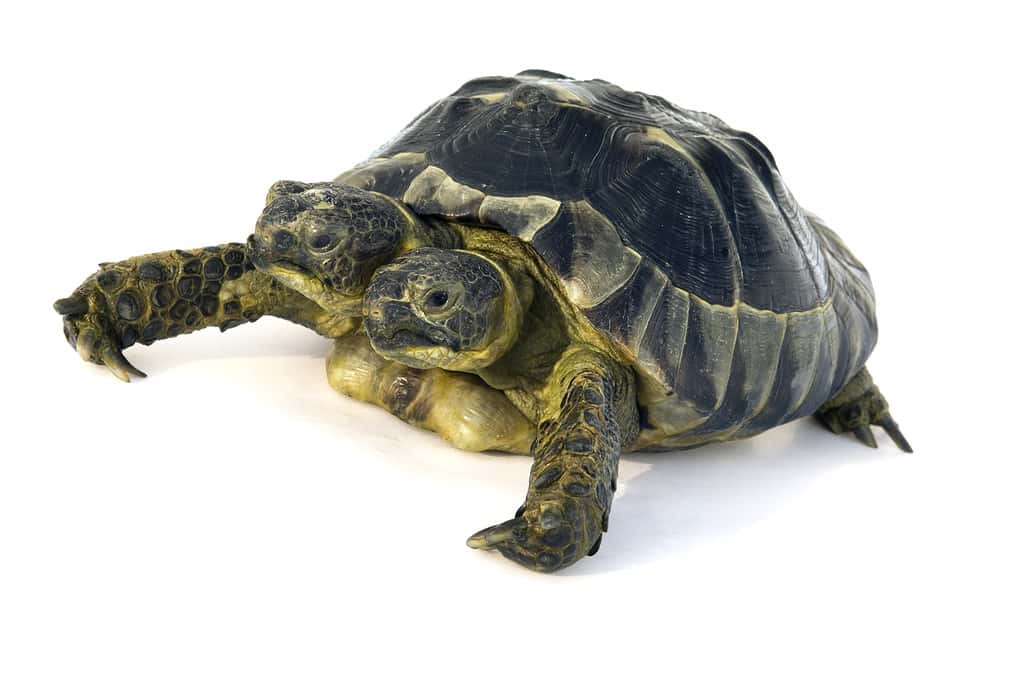A special tortoise named Janus recently celebrated his 26th birthday at his home — the Natural History Museum in Geneva, Switzerland. So far, nothing out of the ordinary — but what makes Janus special is the fact he has two heads with two different personalities to go with each.
According to the caretakers at the museum, he is currently the world’s oldest bicephalous (two-headed) tortoise and a true survival champion.

Janus was born in the museum in the year 1997. He is a member of the Greek spur-thighed tortoise species, scientifically known as Testudo graeca. Greek tortoises are generally known to live for over 120 years and some of them can even reach the age of 200 years in natural settings (but they typically live for only 50 years to 100 years as pets). However, due to his peculiar condition, Janus wouldn’t have lasted long in the wild.
A tortoise is a slow and gentle animal and the only thing that keeps it protected against predators is its ability to hide inside its shell. Since Janus has two heads he is unable to do so. If he had been born in its original habitat, he would have been easy prey. Even at the museum, Janus is always under the supervision of experienced caretakers.
The tortoise also has two hearts and two pairs of lungs working in the same body. Technically speaking, Janus is two tortoises. Angelica Bourgoin who leads the team that looks after Janus at the museum told Reuters:
“The right head is more curious, more awake, it has a much stronger personality. The left head is more passive and loves to eat.”
Two heads are better than one (but they demand more attention and affection)
Janus was named after the Roman god of duality. Similar to the double faces of the deity, the two heads of the tortoise represent two different personalities.
The left head controls the left side of Janus’ body and the right head controls his side. Left-hand-side Janus has a calmer personality and loves food. In contrast, the right-hand-side Janus is more speculative, alert, and active. They don’t like to eat the same things and sometimes they even want to walk in opposite directions, which can be incredibly frustrating for the tortoises forced to be forever bunkmates. Dealing with such situations is a unique experience for the caretakers as well.
Since the two heads are branching out from the same body, their skins are always at risk of developing sores due to getting rubbed against each other. Unfortunately, this is just one of the many complications that Janus faces.
For instance, when a normal tortoise’s body gets flipped, the tortoise can eventually flip back on its feet. However, it is very difficult for Janus to flip back to normal on his own and if he remains flipped on his back for some time, it may even cost him his life.
This is why Angelica Bourgoin and her team are always keeping an eye on every movement of the two-headed tortoise. He also suffered from a bladder stone in the past. Luckily, after surgery, the stone was completely removed and now his bladder is all well.
The team has designed a personalized routine for Janus to give him the best care possible. As part of the routine, the tortoise is given organic vegetables and fruit salad. In addition, he receives a daily body massage and an occasional vaseline-based treatment to prevent the occurrence of sores on his skin. His caretakers bathe him in a solution made of green tea and camomile plant extract. As far as fitness training is concerned, Janus is taken for long walks and sometimes he also gets to ride a specially designed skateboard.
“I think it’s because of the attention we give him and our devotion that he’s still here today,” Bourgoin explained, adding that she often talks to Janus when he is feeling a bit under the weather and cheers him up by playing his favorite music.
It’s a remarkable achievement for Janus and his team, and a testament to how much our ability to care for animals has improved. For all we know, Janus’ best years may still lie ahead. In the meantime, the team in Geneva will continue giving Janus the best care they can.


